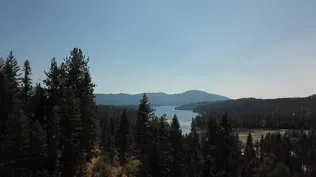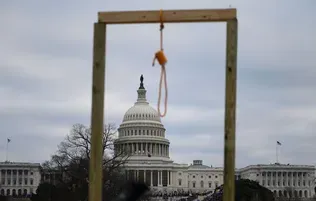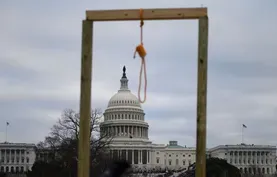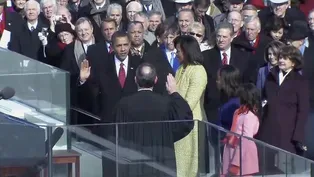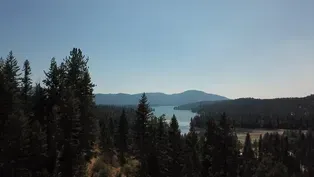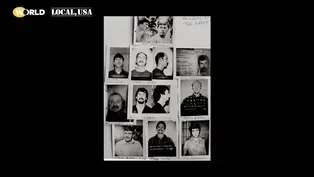
Extremism in America
Season 6 Episode 7 | 27m 31sVideo has Closed Captions
As extremist beliefs and violence were downplayed, a dangerous ideology grew as a threat.
According to government officials, domestic terrorism by white supremacists is the nation's most urgent threat. EXTREMISM IN AMERICA, from Retro Report and The WNET Group’s Exploring Hate initiative, shows how the spread of extremist beliefs and violence was downplayed for decades by policymakers and law enforcement even as this dangerous ideology, fueled by racism, grew into a potent force today.
Problems with Closed Captions? Closed Captioning Feedback
Problems with Closed Captions? Closed Captioning Feedback
Funding provided by the Corporation for Public Broadcasting. Additional funding provided by the John D. and Catherine T. MacArthur Foundation, The Wyncote Foundation and the National Endowment for the Arts.

Extremism in America
Season 6 Episode 7 | 27m 31sVideo has Closed Captions
According to government officials, domestic terrorism by white supremacists is the nation's most urgent threat. EXTREMISM IN AMERICA, from Retro Report and The WNET Group’s Exploring Hate initiative, shows how the spread of extremist beliefs and violence was downplayed for decades by policymakers and law enforcement even as this dangerous ideology, fueled by racism, grew into a potent force today.
Problems with Closed Captions? Closed Captioning Feedback
How to Watch Local, USA
Local, USA is available to stream on pbs.org and the free PBS App, available on iPhone, Apple TV, Android TV, Android smartphones, Amazon Fire TV, Amazon Fire Tablet, Roku, Samsung Smart TV, and Vizio.
Buy Now
Providing Support for PBS.org
Learn Moreabout PBS online sponsorshipTINA McDUFFIE: The following program contains material that may be disturbing.
Viewer discretion is advised.
MAN: The idea that whites are under threat is probably the single most important thing driving the really dramatic expansion of the radical right.
McDUFFIE: The rise of domestic terrorism and hatred in the United States.
MAN: The radical right was growing, and it was becoming more lethal, more dangerous by the day.
McDUFFIE: Presented by Retro Report, in partnership with the WNET groups "Exploring Hate" initiative: Extremism in America.
♪ ♪ JOE BIDEN: Domestic terrorism from white supremacists is the most lethal terrorist threat in the homeland.
MAN: Why is the radical right growing?
Why are these ideas resurgent in such a dramatic way?
CROWD: Jews will not replace us!
MAN: We've been unwilling to really grapple with our history.
(keys clacking) We have to understand where this problem has been in the past and what's kept us from addressing it.
MAN: The white male is through in America.
MAN: These groups have incubated, unchallenged by the federal government.
MAN: We've seen this movement grow from a fringe phenomenon, disconnected, weak.
We are in a different place now.
MAN: People have been ringing the bell.
Nobody's been listening to the bell being rung.
♪ ♪ (radio static) ANNOUNCER (on radio): You're listening to Alan Berg on K.O.A.
BERG: Remember when I left you?
You never shut up!
MORLIN: Alan Berg was a very famous talk show personality, and he was really outspoken and would love to take on racists.
BERG: If you're not a Christian, you're unAmerican, is that your point, sir?
MAN (on phone): That's right!
MORLIN: He was driving back to his condo alone in his Volkswagen Beetle, and somebody gunned him down in his driveway.
REPORTER: Police say Berg's body was riddled with bullets.
DETECTIVE: Shell casings on the driveway.
MORLIN: It was a huge story throughout the country.
Here's a Jewish talk show host who was assassinated.
Who could carry out such a horrible crime?
REPORTER: Police in Denver say they have no firm leads yet regarding the murder of a radio talk show host.
NARRATOR: The story behind Alan Berg's murder starts with an ideology that took root a thousand miles from Denver in a remote corner of northern Idaho at the Aryan Nation's headquarters.
CROWD: Heil victory!
Heil victory!
NARRATOR: The 20-acre compound was home to Richard Butler, who preached to his followers that white people were under threat from racial minorities, immigrants, and Jews, whom he believed controlled the federal government.
BUTLER: We are faced with extinction.
We have a right to do whatever we can do to preserve ourselves.
(camera shutter clicking) NARRATOR: Butler soon attracted the attention of FBI agent Wayne Manis.
MANIS: The most significant thing that Richard Butler did is he would have a gathering of people from all these different organizations.
MARK POTOK: They might be Klansmen, they might be skinheads.
CROWD: What do we need?
White power!
All of these people would come together for the Aryan World Congress.
NARRATOR: Robert Matthews was one of them.
Why don't you Jews get the heck out of here?
NARRATOR: Matthews gathered some of the men from the Aryan Nations and other groups and formed a secret splinter cell that broke off from the Aryan Nations.
They pledged their lives to create a whites only nation.
They were called the Order, a name taken from a novel.
POTOK: The Turner Diaries depicted a group of people who made war on the federal government, culminating in the blowing up of the FBI headquarters and the nuclear bombing of the state of Israel.
MORLIN: They thought, "Why should this be fiction?
Why don't we take up arms and start a race war?"
POTOK: The Order wanted to fund the rest of the radical right to create, essentially, an army of white men.
NARRATOR: To fund their plan, the order attacked an armored truck on a highway in California in broad daylight in a brazen robbery.
MORLIN: They opened the back of the armored truck and helped themselves to $3.6 million.
They made one mistake, however.
They left behind a handgun.
MANIS: And when they leave, we have the pistol, and that opens up a whole avenue of investigation.
MORLIN: That handgun was traced to a member of the Order.
REPORTER: Scores of FBI agents were shipped onto this rural island in Washington state prepared to do battle.
MORLIN: The FBI finally finds out that Matthews is holed up in a cabin on Whidbey Island and that he's heavily armed.
MANIS: Bob refused, refused to surrender.
We were met with gunfire.
I took about seven rounds just over my head.
NARRATOR: After a 36-hour standoff, a flare ignited the cabin, and Matthews burned to death.
The other members of the Order were quickly arrested.
During its investigation, the FBI uncovered plans to poison major water supplies and threats to hang members of Congress.
And they found the gun used to murder Alan Berg.
McDANIEL: I have absolutely no doubt in my mind that had we not stopped them, there would have been federal buildings that have been blown up.
These guys were for real.
Prior to the Order, domestic terrorism was like, what's that?
Klansmen had killed civil rights workers and so forth, but this was a new breed of animal.
I mean, this was a group that was bent on war with the United States government.
NARRATOR: It was a wakeup call that the white supremacist movement was a growing danger.
The federal government believed the Order was not acting alone and that their crimes were part of a larger plot orchestrated by the leaders of several far right groups, including Richard Butler.
REPORTER: Were you the leader of this conspiracy?
- No, I was not.
NARRATOR: In a bold move, prosecutors brought nine of them to trial on charges of seditious conspiracy or plotting to overthrow the government.
REPORTER: Prosecutors hope that in convicting the godfathers of organized racial hatred, they'll have finally broken the back of the white supremacist movement.
The idea was that they could wipe out this movement in one fell swoop.
And I'm just doing my duty.
NARRATOR: The government's key witness was James Ellison, a former extremist leader.
He testified that he attended secret meetings at the Aryan World Congress, meetings he described to his deputy, Kerry Noble.
Jim said most of the plans included counterfeiting money, robbing armored cars to help finance the right wing movement.
You know, just all the men on alert.
This was real, a real ideology, a real goal for people.
NARRATOR: But Ellison also had credibility problems.
He liked to call himself King James of the Ozarks, contradicted himself on the witness stand, and was trying to get a reduced sentence.
His testimony was not enough.
REPORTER: A stunning verdict this afternoon in the trial of 13 white supremacists.
POTOK: The defendants were acquitted of all charges, every single one of them.
The government had simply overreached.
Thought we had proved it beyond a reasonable doubt, but apparently we hadn't.
MORLIN: The defense attorneys said "How on earth "could this ragtag group of people possibly overthrow the U.S.
government?"
And that was a question that the federal prosecutors could never overcome.
REPORTER: The defendants left the courtroom triumphant and defiant.
BEAM: One: I want to praise Yahweh's holy and precious name.
Two: I want to say to hell with the federal government.
POTOK: The government had tried to destroy the radical right in America, and it failed abjectly.
NARRATOR: In the years after the trial, that radical ideology continued to spread, surfacing again in a shocking attack in 1995.
REPORTER: It is apparently the single deadliest terror attack on U.S. soil ever.
An army veteran named Timothy McVeigh, who was radicalized by some of the same antigovernment ideas that inspired the Order, including The Turner Diaries, blew apart the federal building in Oklahoma City, killing 168 people.
BILL CLINTON: It was an act of cowardice, and it was evil.
MORLIN: It wasn't until 1995 that the message of domestic terrorism really came home in this country unquestionably.
And it was after the Oklahoma City Bombing that the justice department woke up.
We must intensify our focus on the threat to America from within.
O'CONNOR: The FBI started going in and finding out where the violence is and getting in front of the violence, making arrests.
You got every agency in the government coming out after people.
That scares you if you're in the movement.
You start to see the reality of what could happen.
NARRATOR: But the crackdown was short-lived.
After the 9/11 terrorist attacks, the government's focus shifted again, this time to international threats.
We really took our eyes off of a lot of other things, including white supremacy, and domestic terrorism.
For the most part, it wasn't looked upon as important.
The movement basically never ceased, but they bide their time, and then they just wait.
(crowd cheering, applause) BARACK OBAMA: At this defining moment, change has come to America.
ROBINSON JR.: I never dreamed that I would see a person of color as the president of our nation.
I never dreamed it.
OBAMA: To put their hands on the arc of history... ANDREW ROBINSON: I was up following the results... ...and bend it once more toward the hope of a better day.
I got up and I looked out the window, and the church was ablaze.
(sirens blaring) ROBINSON JR.: Our phone rang, and the words I heard was, "They are burning our church to the ground."
And what was left was rubble.
And, well, who did this?
REPORTER: Three men set a massive fire that destroyed the Macedonia Church of God in Christ.
REPORTER: Prosecutors say it was a racially motivated crime, an expression of anger that an African American was elected president.
ROBINSON JR.: I have them to declare, "We did it because it was Barack Obama was elected president."
To protect and defend... ROBINSON JR.: Just reinforced for me the hold that racism and hatred has on this country.
POTOK: People on the extreme right understood that the percentage of white people in America was dropping every year.
So when Obama appeared on the scene, there was a massive freak-out on the radical right.
CROWD (chanting): Sieg heil!
JOHNSON: We started seeing white supremacist groups holding rallies, and in these rallies, the number of participants continued to grow.
NARRATOR: Daryl Johnson was part of a small team at the Department of Homeland Security that tracked domestic extremism.
In early 2009, while the government was focused on the threat from overseas, he wrote a report warning that the threat at home was reemerging.
JOHNSON: The report was a warning that you better start preparing yourselves for this shift in the threat landscape.
From Al Qaeda to more homegrown violent extremism.
NARRATOR: The report was quickly leaked, and Johnson found himself at the center of a political firestorm.
REPORTER: Outrage tonight over an intelligence report.
MAN: I would like him to be fired from the Department of Homeland Security.
JOHNSON: The primary accusations were the term "right wing" equated to conservatives.
They thought it was unfairly, demonizing Republicans.
That we were going to be spying on all conservatives.
RUSH LIMBAUGH: Is nothing more than a partisan hit job filled with lies and innuendo that portrays any conservatism as right wing extremism.
NARRATOR: The section that prompted the most outrage was a warning that extremists would try to recruit military veterans.
CARTER: They serve their nation and they have left the military service, and they've been good citizens of this congressional district, and yet... (taps poster loudly) they lumped them with Timothy McVeigh.
Is this America?
Is this what we're used to?
We are normal, God-fearing people who love this country, and now we're the threat?
O'CONNOR: Politically, you can't say that the military is being recruited by extremist groups.
People working domestic extremism, we all knew that that report was accurate.
NARRATOR: Under pressure, the Obama administration apologized to veterans, withdrew the report, and restructured Johnson's unit.
JOHNSON: We got rid of the domestic terrorism focus, and they reassigned those in my former unit to look at Al Qaeda and critical infrastructure threats.
NARRATOR: The Department of Homeland Security has defended its handling of the report, and both Homeland Security and the FBI say they did continue to gather intelligence on domestic terrorism.
But 13 years later, the report has been called an example of how politics undercut the fight against extremism.
SIMI: It quashes this window of an opportunity we have to recognize this problem because it sends the message that this is an issue that we can't really have a discussion about.
There was a great reluctance among many officials to say what was obvious, which was the radical right was growing, and it was becoming more lethal, more dangerous by the day.
♪ ♪ OPERATOR (on phone): Milwaukee County 9-1-1.
Yes, Milwaukee Sheriff.
MAN (on phone): Some guy's shooting their gun at some temple or something.
MAN: There is shooting!
WOMAN (on phone): Oh my God, they're shooting!
Oh my God!
OPERATOR: Did anybody get hit?
Hello?
(gunshots, dial tone) PARDEEP KALEKA: I get a call from my mother, and she's whispering, "I'm in the closet.
"We're safe.
Try to call your dad to see if he's all right."
And she kind of hangs up and says, "I can't talk.
I don't want to...
I don't want to give away our hiding spot."
OPERATOR (on radio): He is a balding male with glasses may have gone inside with a gun, and there were shots fired.
KALEKA: Shortly after that, I get a phone call from my father's phone, expecting to hear my father's voice.
What I hear is another priest inside who picked up the phone and said, "Hey, we need help.
People are bleeding."
(siren blaring, indistinct radio chatter) (faint gunshots) MURPHY: I realize I'm going to be the first one there.
I entered a lot.
This guy was shooting everybody.
He comes out of the temple.
I could see a gun.
He raises it up.
I raised mine.
We shoot from about 40 yards away.
I missed, and his shot hit me right in the face.
OPERATOR (on radio): We have one officer shot.
MURPHY: And, in the end, I take 15 shots.
My backup, Sam Lander, came.
(officer shouting) Sam shot him, went down, and less than a minute, killed himself.
REPORTER: Please focused their investigation on this man, Wade Michael Page.
REPORTER: A military vet believed to be a white supremacist.
These are all the pictures of everyone that lost their lives.
My father had been shot five times from close range and didn't make it.
Seven people altogether died.
This became the deadliest hate crime committed at a place of worship by an affiliated white supremacist in nearly 50 years.
DICK DURBIN: Oak Creek, Wisconsin, Police Department... (voiceover): We held the first hearing on this terrible, violent attack.
We've got to bring these issues before the public.
They have to see them in real terms.
Since 9/11, Congress has held dozens of briefings on the threat posed by al Qaeda and its affiliates.
This is the first hearing in many years on the threat of violent domestic extremism.
I was asked if I would testify before Congress.
My message was, this threat is real, and it is growing.
(on footage): Our failure to act now will surely embolden the enemy and bring more attacks.
The disheartening thing was Dick Durbin, for the first 20 to 30 minutes, was the lone senator attending.
No Republicans attended.
DURBIN: I don't think people took it as seriously as they should have.
It's spreading, and that's something we didn't want to hear.
JAVED ALI: The overwhelming majority of the counterterrorism focus then was still on the international terrorism side.
In part because of the scale and scope of the threats.
From there, things really started to change in terms of this uptick in lethal attacks in the United States.
The nation is waking up to news of a senseless act of violence in Charleston, South Carolina.
REPORTER: One of the deadliest attacks against a Black church in U.S. history.
DYLANN ROOF: Somebody had to do something because Black people are killing white people every day on the streets.
ALI: Even though there was this horrific attack, no one was calling it domestic terrorism.
REPORTER: FBI director James Comey says that he does not believe that Dylann Roof's actions were terrorism because of how it is defined under the law.
ALI: These types of incidents weren't just run-of-the-mill crimes.
REPORTER: It happened at the Tree of Life Synagogue.
REPORTER: Bowers hurled words of hate against Jews as he murdered them.
Here in El Paso tonight, a gunman showing up at a Walmart... A mass shooting in Buffalo, New York.
REPORTER: The 18-year-old was motivated by a conspiracy theory involving a plot to eliminate the white race and replace it with people of color.
POTOK: The idea that whites are under threat is probably the single most important thing driving the really dramatic expansion of the radical right.
Wade Page had a tattoo of the 14 words.
"We must ensure an existence for white people and a future for white children."
A slogan that was coined by the principal member of the Order, part of the hit team that murdered the Jewish talk show host Alan Berg in 1984.
And this has become an incredibly central slogan for the radical right in the United States.
Wade Michael Page, Dylann Roof are the products of a movement that has been growing for 40 or 50 years.
ALI: Potentially, we could have gotten ahead of some of these threats, or at least called them something else that would have given a different context to the threat and perhaps led to different decisions about what to do.
But we didn't, and we're left with the situation we're in now.
♪ ♪ KALEKA: There's not a day that goes by that I don't think about what happened that day.
Not a single day.
So this is the first shot.
If the shooter had been a Muslim, if the shooter had been brown, and if the communities inside were white, if they were Christian, if they were part of the mainstream of what we deem as valuable, would it have been different?
And I think that, ten years later, I still struggle with is our pain enough?
There's lots of Wade Michael Pages out there.
So we better start understanding the dynamic.
♪ ♪ KELVIN PIERCE: My father was Dr. William Pierce, and he was the founder and the leader of the National Alliance, a white supremacist hate group that he hoped would one day bring about the violent overthrow of the U.S. government.
He was also the author of The Turner Diaries, the novel about an eventual race war.
There have been numerous violent acts attributed to the book.
WILLIAM PIERCE: We catch people's attention, give them information they wouldn't have otherwise, and inspire them to do something about it.
(crowd chanting) KELVIN PIERCE: When I saw those people marching...
CROWD: Jews will not replace us!
KELVIN PIERCE: ...it was like I was transported back to my childhood in an instant.
CROWD: Blood and soil!
Blood and soil!
Blood and soil!
Blood and soil!
O'CONNOR: Hundreds of white males, mostly males, college age, showed up at Charlottesville chanting these antisemitic white power movement chants.
"Fire up the ovens, boys," and "Jews will not replace us."
That was really kind of the shot heard round the world.
CROWD: Jews will not replace us!
NARRATOR: The rally which brought together white nationalists, neo-Nazis, and others brought hate out in the open.
PETE SIMI: The Unite the Right rally was the largest public rally for white supremacists in more than a decade and it turned out to be very violent.
(man shouting) NARRATOR: Clashes between white nationalists and counterprotesters culminated when a neo-Nazi slammed his car into the crowd, injuring more than two dozen people and killing 32-year-old Heather Heyer.
SIMI: The car attack that takes Heather Heyer's life was a show of strength for them.
DURBIN: Many of these groups that used to hide in the shadows come out now and boldly march in the state of Virginia and other places.
They feel somehow licensed and emboldened to do it.
It's more public now.
DAVID DUKE: We are determined to take our country back.
We're going to fulfill the promises of Donald Trump.
NARRATOR: The march came seven months after Donald Trump took office, and his response became one of the defining moments of his presidency.
TRUMP: You had a group on one side that was bad, and you had a group on the other side that was also very violent.
And nobody wants to say that, but I'll say it right now.
O'CONNOR: I've talked to people within the movement that clearly believed that the president's statements were a statement of support.
And you had some very bad people in that group, but you also had people that were... very fine people on both sides.
♪ ♪ NARRATOR: After the marches, Kelvin Pierce decided to go public with the story of how he rejected his father's beliefs.
And in the years since, he watched as white supremacist and other extremist violence has risen to the highest levels in decades.
KELVIN PIERCE: I think my father would have absolutely delighted in what's happening in the country and the fact that racism really bubbled up to the surface.
NARRATOR: At the same time, antigovernment and other extremist groups have become more public, joining protests against pandemic lockdowns in 2020...
CROWD: Treason!
Treason!
NARRATOR: ...and fighting openly with racial justice protesters.
(bleep) Antifa!
BRIAN MURPHY: Particularly after George Floyd was killed, that's where a lot of these groups really started to coalesce, organize.
Instead of tamping that down, really, gasoline was poured onto it with the rhetoric of the Stop the Steal.
CROWD: Stop the steal!
Stop the steal!
NARRATOR: On January 6th, members of extremist groups joined protests at the U.S. Capitol against what they called a stolen election.
TRUMP: We fight like hell, and if you don't fight like hell, you're not going to have a country anymore.
NARRATOR: And while most people that day were not connected to any extremist organization, members of the Oath Keepers, Proud Boys, and other groups were on the frontlines of the attack and have been accused of helping plan it.
(small explosion) MURPHY: These things are all coalescing together into the perfect storm.
Polarization on the right and the left, conspiracy theories, the idea that the election was rigged and stolen was really a new kind of conglomeration of things.
O'CONNOR: People built a gallows on the front lawn of the Capitol, saying that they wanted to hang Mike Pence, the Republican vice president.
CROWD: Hang Mike Pence!
Hang Mike Pence!
KELVIN PIERCE: When I saw that gallows, to me, you know, reminded me of "The Day of the Rope," the chapter in the book where they really talk about grabbing everybody that had anything to do with a threat to the white race and hanging them.
POTOK: We've seen this movement grow from a fringe phenomenon that involved a few thousand people around the country, disconnected, weak, with no political pull.
We are in a different place now.
Pieces of rhetoric that have been spewed to the extremes-- now that information permeates much more mainstream conversations.
MORLIN: It takes these events to sort of jolt the American conscience awake.
MAN (on recording): Hate is our law.
There were a lot of people in the '80s... MAN: What do we need?
CROWD: White power!
MORLIN: ...and in the '90s that, you know, said domestic terrorism is an important issue.
People have been ringing the bell.
(gunshot, siren blaring) Nobody's been listening to the bell being rung.
Having lived and covered a lot of these stories as a journalist, I'm certainly glad to hear that they're now saying domestic terrorism is a real deal.
And I certainly say it's about time.
McDUFFIE: Follow the conversation for tonight's Local, U.S.A. using #ExploringHate.
♪ ♪ ♪ ♪
Extremism in America | Trailer
Video has Closed Captions
As extremist beliefs and violence were downplayed, a dangerous ideology grew as a threat. (1m 38s)
Extremism in America | Great Replacement Theory
After Pres. Obama's election, the 'great replacement' theory spread and hate crimes rose. (1m 2s)
Extremism in America | Preview
Video has Closed Captions
As extremist beliefs and violence were downplayed, a dangerous ideology grew as a threat. (30s)
Extremism in America | Sikh Temple Mass Shooting
Rise of mass shootings at houses of worship from Oak Creek to Charleston and Pittsburgh. (1m 3s)
Extremism in America | The Order
The rise of white supremacy and the beginnings of domestic terrorism. (1m 2s)
Providing Support for PBS.org
Learn Moreabout PBS online sponsorshipSupport for PBS provided by:
Funding provided by the Corporation for Public Broadcasting. Additional funding provided by the John D. and Catherine T. MacArthur Foundation, The Wyncote Foundation and the National Endowment for the Arts.
